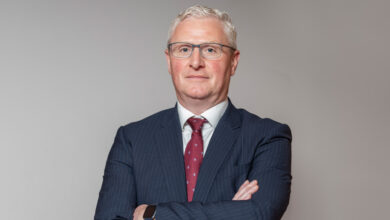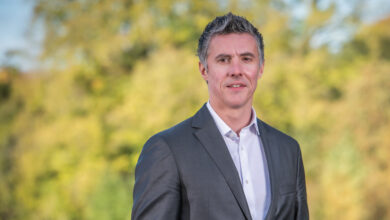Developing dialogue
 ClimateXChange Director of Policy, Andy Kerr talks to Adam Morton about Scotland’s progressive energy policy and the importance of ensuring local communities benefit from energy projects.
ClimateXChange Director of Policy, Andy Kerr talks to Adam Morton about Scotland’s progressive energy policy and the importance of ensuring local communities benefit from energy projects.
Scotland’s produces a lot of renewable energy. Because of this, ClimateXChange’s Director of Policy, Andy Kerr believes that decisions are now being taken by the Scottish government that are “diametrically” opposite to what the Conservative Government’s direction on energy policy.
Renewable energy has proved to be a real success in Scotland. In 2007 the total installed capacity of renewable electricity was 2.6 GW by 2014 this had tripled to 7.5 GW. The bulk of this renewable electricity (75 per cent) is supplied by onshore wind farms, roughly 25 per cent comes from hydro sources and a series of small but rapidly growing sources such as solar make up the rest.
Targets
These market conditions have led to the country revising its targets for renewable energy. Originally, the Scottish Government targeted having 20 per cent of Scotland’s net electricity use generated from renewable sources by 2020. However this has now been revised up to 100 per cent of net electricity consumption. According to Kerr, Scotland consumes about 35-40 TW hours of electricity a year and currently produces over 50 TW hours of electricity per year. This revised renewable electricity target will not, Kerr says do away with the need for interconnectors or other generation for intermittency issues but he estimates that by 2020 close to 35 TW hours of electricity will be produced by renewable sources in Scotland.
In 2014, Scotland produced just under 50 per cent of its electricity needs through renewable sources. In 2015 over 50 per cent was generated and at present four GW of wind farms are under construction with 3.5 GW awaiting construction, depending on the impact of Government changes to subsidies.
At present in Scotland, according to Kerr, onshore wind is “pretty close to grid parity”, which could make locating turbines in Scotland an attractive proposition for investors in future even without government subsidies.
Talking about Scotland’s chance of hitting this 100 per cent target, Kerr states that while energy policy is reserved by the UK Government, within the powers Scotland has to promote renewables and energy efficiency there is a lot it can do to support local energy systems. “The answer is I think, within the powers they have they can go a long way down that route of creating local energy systems even though UK energy policy is going a different direction,” said Kerr. “In Scotland while the SNP is in power there won’t be any nuclear power and we have only one big gas station which is only used for grid balancing and nothing else, so the notion of this large scale gas and nuclear future doesn’t make any sense in Scotland.”
Kerr credits a number of factors in allowing Scotland to get this close to its target including political leadership, building on Scottish technical expertise, the socialising of the cost across Great Britain and the tweaking of the planning laws to encourage renewable energy development in a way that didn’t happen in England and Wales.
Community ownership
However, Kerr believes that with this success, Scotland’s energy market is now pulling in a different direction to the United Kingdom and is focused on creating local energy systems that blur the line between electricity, heating and transport and provide the community with a sense of ownership. To promote this model Kerr believe high quality effective communication is key.
The key reasons, Kerr believes for effective communication are:
• Normative – it is the democratic thing to do to disseminate as much information as possible;
• Instrumental – there is lots of good experience that if you have a community owned wind farm it is far more likely to go through planning initially if you have community ownership;
• Substantive – engaging the public is important and not something that can be imposed by the government.
Kerr believes communication is of vital importance to future projects but believes the methodology used by many at present is not conducive to gaining support for projects. “We’ve seen a lot of tokenism over the years where companies claim to be consulting, but in practice they are just telling people what is going to happen,” said Kerr. “That consultation effectively becomes a sham. It offers people assurance that their concerns will be taken into account but then nothing happens afterwards, often there is no natural action following the consultation.
“More often than not, participation is deemed to be how many brochures have been taken home or how many people have answered the questionnaire, rather than if the issues have actually been addressed. In other words, a genuine dialogue rather than just informing them and yes, genuine dialogues are often messy and difficult but they are vitally important.”genuine dialogues are often messy and difficult but they are vitally important
One of the main sticking points to the arrival of energy projects is, according to Kerr, different people want different things. To combat this he believes that effective communication is needed to bring them on board. “The energy system for the last 40-50 years has been imposed on communities and when we talk of radical change we are at the point now where it is not a matter of can you stick more turbines in if you want to deliver an energy transformation you have to improve a whole range of things and the only way to do that is to bring people with you,” he said.
“You need to have a dialogue with them rather than impose something on them so the dialogue and responding to their concerns is key and actually that’s one of the key learnings that has come out of the Scottish work that you can’t just impose on people you have to get them believing it is the right thing to do.”
Benefits
Kerr claims that the social benefits of community ownership is clear, as is the economic benefit. “If you have local ownership what you get is a local recycling of income from the energy assets,” said Kerr. “With local ownership what we find is you tend to recycle a lot more if people have local ownership.” To give these benefits as much chance as possible Kerr believes that the dialogue should begin at the start of a projects lifespan, not moments before the ground work is due to begin.
“You should be talking to the community at the high level planning phase, telling them your intention for the region over the next 20 years,” said Kerr. “Engaging with communities truly is a necessity and there is a wide range of methods to facilitate dialogue. The most crucial of which is being able to show a response to the feedback received and maintain the engagement right through the projects development.”





